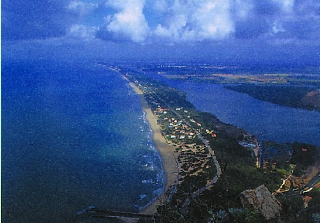The Parco Nazionale del Circeo is situated along the Tyrrhenian coast in the South of Rome, between Anzio and Terracina, and it extends itself for about 8.500 hectares in the province of Latina, in particular in the Towns of Latina, Sabaudia, San Felice Circeo and, for the insular part of the Island of Zannone, Ponza. Established in 1934, the Parco del Circeo was born in order to protect not only a single species but also a rich group of typical biomes with a consequent abundance of species which today has been defined as biodiversity. the different environments of the Park can be easily reached by several roads, and visited through by public roads and by roads linking one estate to the other (wetlands and other agricultural areas between the forest and the promontory), pedestrian paths (on the promontory and in Zannone), cycling and pedestrian tracks with pathsigns (in the forest), and some equipped paths (didactic path from the Visitor Center, memory path to Cocuzza, sentiero natura "botanical garden" in Villa Fogliano) with informative panels and equipped access (dune). Moreover, the Park is well-organised as far as handicapped people are concerned, thanks both to its natural plain ground and to the richness in paths which are accessible also with orthopaedic wheelchairs led by guides, and to the presence in the Visitor Center of some structures and equipment (sanitary service, crawler track for stairs) dedicated to specific activities to improve the general accessibility of the paths: for instance, the creation of the sentiero natura for blind people which has been integrated to the sentiero natura "botanical garden" in Villa Fogliano. |
Extends itself along the coast, from the slopes of the promontory and for about 25 Km northwards to Capo Portiere. It is a geologically and vegetationally delicate area consisting in a continuous series of sandy reliefs reaching a width of 250 m. Also in this case we can distinguish a less protected sea-side slope with a pioneer halophilic vegetation and an inner slope which is protected by the sea wind full of saltiness, which houses high and low Mediterranean maquis.
Next to the dune and under the lee of it there is a wetland consisting in a series of four Coastal Lakes (Lake of Paola or of Sabaudia, Lake of Caprolace, Lake of the Monaci, and Lake of Fogliano) and of Wetlands, which are seasonally flooded and which together with the grasslands-pastures form a group of territories which has been declared "Wetland of International Interest".
The wonderful natural mosaic of the Park is enriched by important prehistorical and archeological finds witnessing man's presence in the Circeo since remote times. As a matter of fact, the several caves and natural shelters of the promontory are very important archaeological sites in which, in addition to the recovery of a skull of the Neanderthal Man, many other finds are an evidence of the presence of man and of his activities during the prehistoric periods. The archaeological finds mainly date back to the Roman period, when the great technical ability allowed the realisation of works of residential and hydraulic engineering like the Torre Paula's channel port, or the spa and residential complex of the Domiziano's Villa, which have been preserved till today. The Domiziano's Villa offers us many artistic finds that have been displayed in several museum, like the Apollo by Kessel and the Fauno with the transverse flute, which decorated the residential and spa rooms of the imperial settlement.
|
|||

